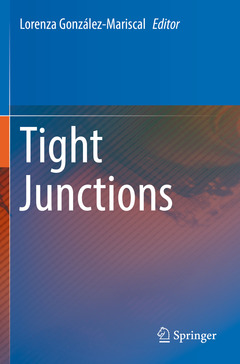Tight Junctions, 1st ed. 2022
Coordonnateur : González-Mariscal Lorenza

Tight Junction book
Table of Contents
Chapter 1: A historical and evolutionary view of tight junctions. Marcelino Cereijido
Chapter 2: Tricellular tight junctions. Mikio Furuse and Tomohito Higashi
Chapter 3: Mechanosensitivity of tight junctions. Alpha S. Yap
Chapter 4: Intracellular traffic and non-canonical roles of ZO-2 protein. Lorenza González-Mariscal
Chapter 5: Impact of claudin-2 and occludin expression in inflammation disorders. Jerrold R. Turner
Chapter 6: Tight junctions in the inflamed gut. Porfirio Nava
Chapter 7: Intestinal barrier disruption by enteropathogenic Escherichia coli. Gail Hecht and Rocio Tapia
Chapter 8: Tight junction barrier function regulation by microbiota. Sean ColganChapter 9: Claudin-7 participation in cell-substrate adhesion, cell migration, salt balance in the renal collecting duct and gut cell renewal and differentiation. Yan-Hua Chen
Chapter 10: Regulation of the alveolar epithelial barrier by claudin-5. Michael Koval
Chapter 11: Regulation of the blood-retinal barrier by occludin phosphorylation, norrin and sonic hedgehog signaling. David Antonetti and Monica Diaz-Coranguez
Chapter 12: Transmigration of metastatic cells through the blood-brain barrier. István Krizbai and Imola Wilhelm
Chapter 13: Endocytosis of tight junction proteins. Anuska Andjelkovic
Chapter 14: Regulated degradation of claudins. Gerardo Contreras.
Provides a detailed and contemporary overview on the current research in one of the core topics of neuroscience
Discusses a range of primary areas of growth, including research on the relationship of tight junctions
Offers insight in the relation between tight junctions and cell migration and invasion
Date de parution : 06-2023
Ouvrage de 334 p.
15.5x23.5 cm
Date de parution : 06-2022
Ouvrage de 334 p.
15.5x23.5 cm
Thèmes de Tight Junctions :
Mots-clés :
nervous system; regulation; gene expression; genes; phenotype; proteins; claudins; claudin-2 in inflammation; JAM-A regulates TJ organization in epithelia; paracinguin; ZO-2 moves from the cytoplasm to the membrane; ZO proteins; cell signalling; drug delivery across epithelia; skin and transdermal drug delivery; tight junctions; occluding junctions; zonulae occludentes



